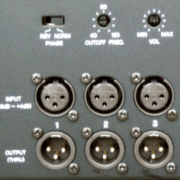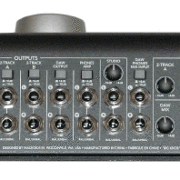PLEASE NOTE: This article has been archived. It first appeared on ProRec.com in October 2008, contributed by then Editor-in-Chief Rip Rowan. We will not be making any updates to the article. Please visit the home page for our latest content. Thank you!
Pros: Terrific sound, totally vintage, tons of sound tweaking capability.
Cons: Could sport a few more samples. Price / performance could be a little higher.
Summary: The definitive ‘Tron.
Are you a vintage keyboard superfreak?
I am. I love the sound of old keyboard technology. Something happened around the time of the invention of the digital sampler: sounds became more pristine, more realistic, and…
… more boring.
In the race to create authentic reproductions of real instruments, samplers began to lose the charm and character of their earlier counterparts. Gone were the glitches, the noise, and the downright weirdness of earlier instruments. The character had been replaced by cleanliness, and something was clearly lost.
Don’t get me wrong. I love the sound of my modern imitative samplers. In the past decade, imitative sampling has finally become a truly beautiful thing. But imitative samplers are no replacement for an authentic Mellotron.
Ah, yes. The Mellotron. Described by electronic music pioneer Jean Michel Jarre as “the Stradivarius of electronic music” and mainstreamed by bands like The Beatles, The Moody Blues, ELO, Yes, and Genesis, the Mellotron is an iconic piece of modern music history.
The fact is, nothing sounds like a Mellotron. In the right setting, the sound can be alternatively silly, haunting, realistic, hypnotic, or psychedelic. The Mellotron is also a masterpiece of engineering genius – or madness: dozens of tape players baked into a mechanical keyboard, in a design that dates back to the late 1940s.
It’s absurd to think it could even work. And if you’ve ever maintained a Mellotron, the truth is – they barely do work. While a well-maintained studio instrument can be quite reliable, once you start really gigging with one, you’re in for a real mess. Dirty or misaligned heads, broken or sticky tapes, and misbehaving motors can all collaborate to ruin the machine’s performance. Forget about trying to tune one. And only a few thousand of these fragile and increasingly rare beasts were ever made. Survivors can set you back thousands. Original tape banks in good condition are practically museum pieces.
What we need is a way to capture the sound of a Mellotron in a tool that won’t easily break or wear out. Ideally, one that costs significantly less than the $3K+ street price of a well-functioning Mellotron.
It’s a perfect job for modern imitative sampling.
And so, in a strange case of sampler-samples-sampler, IK Multimedia has released what it considers to be the de facto Mellotron sample library: the SampleTron.
Based on the IK Multimedia’s SampleTank playback engine, SampleTron provides a suite of 17 authentic ‘tron instruments in a self-contained standalone or VST playback module. Unlike some competitors, the SampleTron library is fully compatible with SampleTank, allowing sounds to be easily manipulated using SampleTank or SampleTron’s built-in controls.
SampleTron includes samples from both ‘tron and ‘tron-like instruments:
- Mellotron M400
- Mellotron MK5
- Mellotron MKII
- Powerhouse
- Novatron
- Vako Orchestron
- Optigan
- Talentmaker
- Chamberlin Music Master 600
- Chamberlin Music Master 400
- Chamberlin Model 200
- Chamberlin M1
- Chamberlin M4
- Chamberlin Rhythmate
- 360 Systems Digital Tron
- Stylophone
- Roland VP-330 Vocoder
Several articles would be required in order to even explain what some of these rare instruments are and how they work. Most (M400, MK5, MKII, Novatron, Chamberlin MM600, MM400, M200, M1,and M4) are variations on the same basic tape-playback system that defines the Mellotron. Three (Optigan, Talentmaker and Vako Orchestron) are devices that used analog optical discs (instead of tape) to produce their sounds. The Powerhouse was an unusual (and extremely rare) lo-fi beatbox device that used 8-track tapes for its media. The Digital Tron, one of the earliest digital “romplers”, was an 8-bit sample playback board marketed as a digital Mellotron. The Stylophone was a very simple electronic organ played by touching a stylus to a set of metal contacts arranged chromatically. And the Roland VP-330 was an early vocoder (the choir sample is used for this collection).
Some sample-based instrument recreations pride themselves for being painfully faithful to the original instruments, right down to emulating all of the original’s shortcomings. IK has opted to make the original shortcomings “optional”. For example, early ‘trons did not provide for tape looping: when you held a key, the recording played back to the end of the tape strip, then stopped. SampleTron offers “loop” and “non-loop” modes which emulate this behavior if desired.
SampleTron also offers a variety of sound manipulating features to take the library well past the range of a tradition Mellotron’s capability. The system provides full A/D/S/R control, a library of chainable effects, variable sample playback modes, filters, and LFO – allowing you to warp the vintage sound as much as you want, or stay completely true to the sound of an original ‘tron. SampleTron also offers a preset / layering capability to allow you to quickly recall specific sounds, and layer up to 16 different instruments together.
I loved this module from the moment I started using it. The sounds are so instantly retro, and the software is so instantly usable, that I couldn’t help myself from just surfing the library and playing for hours. In short, this is a must-have for anyone who wants to add some retro feel to their synthesis arsenal.


